The history of the Institute of Experimental Medicine is very remarkable. An infuriated dog bit an officer of Corps of Guards commanded by Prince Alexander Petrovich of Oldenburg in November 1885. The officer with a military doctor N.A. Kruglevsky went to the laboratory of Louis Pasteur for treatment. The laboratory was in Paris. Prince of Oldenburg was personally acquainted with him. The first vaccinations had been carried out a few months before. N.A. Kruglevsky had been told to study different techniques of the preparation ‘rabies poison’. A.P. Oldenburgsky instructed the veterinarian K.Ya. Gelman to carry out experiments on rabbits infected with rabies, with the aim of spreading ‘Pasteur’s method of combating rabies’ discovered by Pasteur in Russia.
The research laboratory was opened at the Veterinary Infirmary of the Leib Guard Cavalry Regiment. Work on the passivation of the virus received from Paris has begun on June 13, 1886. The ‘Station for Preventive Treatment of Fever by the Pasteur Method’ have opened officially a month later. The research has launched with receiving patients and manufacturing for rabies vaccines. Here, for the first time in Russia, systematic studies of pathogenic microbes were undertaken and measures to combat infectious diseases have been developed. However, neither the premises of the veterinary hospital, nor the staffing capabilities (the station was maintained at the personal expense of A.P. Oldenburgsky) did not allow launching of large-scale studies. The Pasteur Institute was founded in 1888, in Paris. The Hygienic Institute of Public Health was created and led by R. Koch. A.P Oldenburgsky has conceived the same institute in Russia.
The Prince turned to Alexander III. The ‘permission’ for the establishment of the institution at the Holy Trinity Community of Sisters of Mercy, was received on 2 November, 1888. This institution was very similar to the institution in Paris. It was under the guardianship of the Prince, an institution similar to the Pasteur Institute in Paris, ‘without the release of funds from the treasury’. A.P. Oldenburgsky purchased a plot of the specific land with several buildings on personal money on Aptekarsky Island after obtaining permission from the Emperor.
The Institute was consecrated, inaugurated and given the title of ‘Imperial Institute of Experimental Medicine’ on 8 December, 1890. Prince A.P. Oldenburgsky appointed his trustee. The IEM protects by the state. Many of its buildings are architectural monuments.
The first director of IIEM was E-L.F. Sperk. At the first stage of IEM development different methods for diagnosing and combating rabies, cholera, glanders, syphilis, anthrax, tuberculosis, and many other diseases were developed. Opening of Mallein by K.Ya. Gelman allowed to eliminate glanders epidemics. The IEM Special Laboratory for the Preparation of Anti-Plague Preparations was created in 1901. It was known as the Plague Fort (located on an artificial island in the Gulf of Finland on the south of Kotlin Island). Over a million doses of serum were produced against plague, diphtheria, typhoid, scarlet fever, and tetanus until 1915.
Since 1894 S.M. Lukyanov in the Department of General Pathology has expandied the study of metabolism in the intercellular substance and blood plasma. V.V. Podvysotsky has developed a study of the etiology of malignant tumor and their chemotherapy. In the department of pathological anatomy N.V. Uskov, the first Russian hematologist, studied the pathology of blood and blood formation, focusing on changes in white blood cells in various pathological conditions.
I.P. Pavlov performed his classic work on the physiology of digestion in the Physiology department. He was awarded the Nobel Prize for it in 1904. Here, under the leadership of I.P. Pavlov’s studies of conditioned reflexes developed, which formed the foundation of a new direction of science – the physiology of higher nervous activity.
Under the leadership of M.V. Nentsky in the Department of Biochemistry conducted a detailed study of the processes of formation of urea in the animal body. One of the founders of microbiology S.N. Vinogradsky revealed the general picture of the nitrogen cycle in nature in the Department of General Microbiology. V.L. Omelyansky demonstrated the circulation of gaseous nitrogen in the plant world.
By the end of 1920, the State IEM took the position of the country’s leading institution in the field of theoretical medicine. I.P. Pavlov had been heading the Department of Physiology for 45 years, in order to expand the work on the physiology of higher nervous activity. He created a Biological Station near Leningrad (in the village ‘Koltushi’, 1926).
In 1932, a department of evolutionary physiology emerged under the direction of L.A. Orbeli, in the same year A.A. Zavarzin organized the department of general morphology, which became the center of development of theoretical histology in our country.
S.V. Anichkov Department of Neuropharmacology develops innovative drugs based on substances with a fundamentally new mechanism of action, directed delivery systems and increased bioavailability of drugs, reducing unwanted side effects; new pharmacological substances for the treatment of neurological diseases are synthesized, the mechanisms of their action are investigated; a search is underway for new means of pharmacological correction of addictive conditions and post-stress disorders.
The Department of Biochemistry studies the immunological mechanisms of the development of atherosclerosis, the role of lipoprotein modifications in these processes, lipid-protein and protein-protein interactions in a lipoprotein particle; participation in atherogenesis of proteins produced by the cells of the vascular wall, macrophages and complement system.
The Department of General Pathology and Pathological Physiology studies neurohumoral regulation of the protective functions of the body; elucidation of the role of various mediators (orexins, antibiotic peptides, etc.) in the implementation of neuroimmune interactions; search for ways to correct violations of the protective functions of the body during traumatic brain injury, distress, infection.
In the Department of Molecular Genetics carries out experiments on animals, cells, in vitro and in silico study the molecular mechanisms of the emergence, development, regulation, diagnosis and treatment of pathological processes such as inflammation, abnormal fibrillogenesis, malignant cell transformation, hereditary diseases with signs of neurodegeneration, and severe micronutrient metabolic disorders.
The Department of Immunology examines the role of mast cells in neuroimmune interactions; the role of cytokines and growth factors in the functioning of the thymus; mechanisms of autoimmune reactions; the role of immune complexes formed by immunoglobulins of different classes; studies the effect of streptococcus arginine deiminase on the functional activity of cells of the innate and acquired immunity systems.
A.A. Smorodinstev Department of Virology studies immunological defense mechanisms against influenza viruses. This department develops new types of live influenza vaccines against current strains of the influenza virus and respiratory viral infections. Furthermore, specialists of the department develop new approaches to increase the effectiveness and safety of vaccines. The laboratories construct a new generation of vectorized vaccines and associated viral and bacterial preparations.
The Department of Molecular Microbiology analyzes pathogenicity and streptococcus chromosome mapping of A and B groups. Specialists develops himeric protein vaccines against pneumococci and streptococci of B group. The department constructs live probiotic vaccines against streptococci and pneumococci for mucosal immunization and virus-bacterial vaccines. Employees of the IEM develop important technology of obtaining personalized autoprobiotics. The department investigates the antitumor activity of streptococcus strains.
The Department of General and Local Morphology studies the mechanisms of brain development, the initial stages of the formation of adaptive reactions and pathological processes in the central nervous system at different stages of ontogenesis, including aging. The department explores the mechanisms of the pathogenesis of neurodegenerative diseases and structural organization of neurogenic zones. The laboratories study the role of immunological factors in atherosclerotic lesions and the mechanisms of destabilization of atheromatous plaque.
The Department of Medical Biotechnology and Immunopharmacology develops innovative immunopharmacological preparations using genetic engineering technologies based on experimental and bioinformation data, protein isolation and purification technologies, and the production of pharmaceutical substances. In the laboratory of physiology of visceral systems. K.M. Bykov studied the hemodynamic reactions of pulmonary and venous blood flow during myocardial ischemia and pulmonary embolism; stress-induced discoordination of gastroduodenal motility; structural and hemodynamic disturbances in the vena cava system resulting from thrombosis; development of innovative minimally invasive methods for their correction.
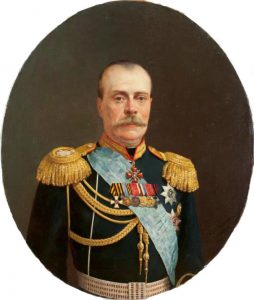
Prince A.P. Oldenburgskiy
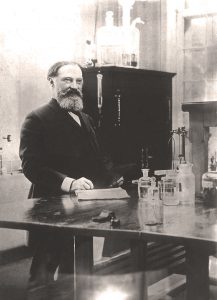
First Director of RIEM Eduard Shperk
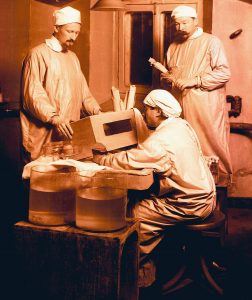
In the laboratory of the ‘Plague Fort’
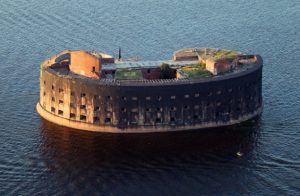
The ‘Plague Fort’
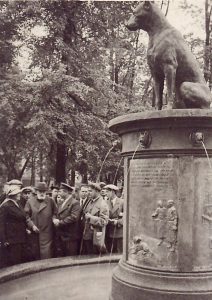
I.P. Pavlov near the Monument to the Dog ‘From Grateful Humanity’ in the park of the Institute of Experimental Medicine
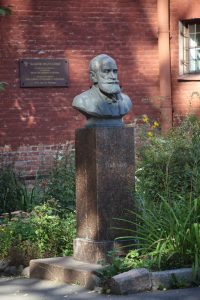
Bust of I.P. Pavlov near the building of the Physiological Department which is named after him



